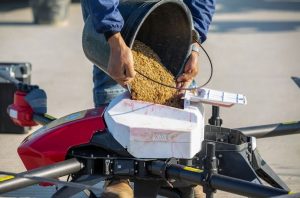The winds of change are set to roar through the farmlands of China, the world’s largest producer and consumer of rice, as drones start to take over planting of the staple crop.
That push for automation has been initiated by agricultural drone maker XAG, formerly known as Xaircraft, which has applied its drone-based direct seeding system—called JetSeed—from the testing stage to commercial adoption on more than 650 million square meters of rice fields in 11 provinces across China since April last year, according to the company.
It expects more small rice farmers and large farm owners to automate, replacing manual seed planting, as a means to raise efficiency, while mitigating labor shortage and the threat of COVID-19.
“[Traditional] rice planting relies heavily on field workers to transplant rice seedlings by hand or machines slowly through the muddy paddy field,” Peng Bin, co-founder and chief executive of XAG, said in an interview on Thursday. “Using drones won’t leave the paddies with potholes that usually [fill up with]waste water and fertilizer. . . It works just like spraying seeds into the paddies with a Dyson hairdryer.”
The urgency of automating how China’s most important crop is planted came to a head early this year, when China’s economy was disrupted by the coronavirus outbreak.
Read this: Meet the man behind China’s talking drones
When COVID-19 loomed over the spring planting season, Guangzhou-based XAG said it helped mobilize drones for various rice farmers, who were facing rural worker shortages, to directly seed their paddies. Direct seeding refers to the process of sowing seeds into the fields without nursery cultivation and transplantation, while cutting down on water use and preserving the soil.
“The pandemic showed the necessity and increased demand for automated farming,” Peng told the South China Morning Post. “Smart devices and systems which can raise efficiency, precision, and ensure environmental protection represent the direction of modern agriculture.”
Compared with large-scale agriculture in major economies like the US, most Asian countries where rice is the staple crop cannot use large expensive machinery, such as driverless tractors, because of the complex terrain and small size of many farms. By comparison, drones are more agile and economical for rice farmers in this region.
XAG describes JetSeed as an “intelligent granule spreading system,” which can be mounted on the bottom of its agricultural drones, whether old or new. This system’s parameters are set up via an XAG app. It ensures that the proper amount of seeds are accurately spread into the targeted topsoil, while maintaining optimum spacing and uniform plant density, according to the company.
It said JetSeed also enables drone seeding at night, which helps ease the issue of less available manpower in China’s rural farming communities. According to recent estimates, an agricultural drone can seed 50,000 square meters of land per hour, which would otherwise take 50 to 60 field workers to complete.

Still, competition in agricultural drones in China is expected to remain heated, as Shenzhen-based DJI—the world’s biggest maker of commercial drones—has sharpened its focus on industrial applications, led by its Matrice line of drones. DJI and XAG are estimated to have a combined 80% share of China’s overall drone market.
With more than 1.4 billion people to feed and plans to cultivate 4.6 million hectares of rice this year, China remains a big enough market for those two companies amid the government’s directive for industries to utilize automation and digital infrastructure to a higher degree. There were close to 50,000 agricultural drones in service across China last year, according to a report by state-run broadcaster CGTN in November.
This article was originally published by South China Morning Post.

